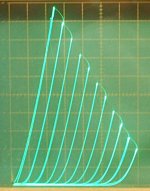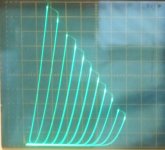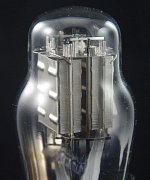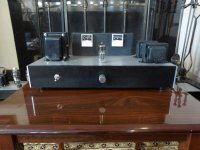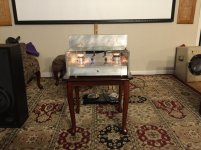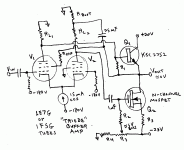Pentodes with local feedback sound more fantastic than triodes, when properly cooked. Solid state amps can sound fantastic too but sadly they do not glow and do not look so impressive...
Very true ...Solid state amps can sound fantastic too but sadly they do not glow and do not look so impressive...
Any valves that aren't used in guitar amplifiers are a very specialized product with low production numbers. Audio tubery is just a bunch of wackos to the manufacturers (for good reason!).
As s-a has already said, the best output triode ever made costs $3 or $4. Made by the folks who, at about the same time, built the computer for the Apollo missions - 'nuf said.
All good fortune,
Chris
As s-a has already said, the best output triode ever made costs $3 or $4. Made by the folks who, at about the same time, built the computer for the Apollo missions - 'nuf said.
All good fortune,
Chris
If they glow it is very short lived, and not good sounding.. 😉
And the GM70 is a real sleeper if you are comfortable and sufficiently experienced to work safely with the plate voltages required.
And the GM70 is a real sleeper if you are comfortable and sufficiently experienced to work safely with the plate voltages required.
ok, so I look on the 'bay now and see ГУ-13 costing $30 each.... not $3 (unfortunately)
Me thinks 4P1L is still a fantastic deal at around $4-5 each. But you really do need 2 of them for each channel.
Sellers from Romania, Russia, Ukraine currently $18 or maybe a bit less for a quad of 4P1L (plus shipping). Its still really decent.
I find that an absolute need to need to reg. the heaters, which adds to the cost. Can't ignore that, but if you do it yourself then you can keep that cost down too.
Ian
Me thinks 4P1L is still a fantastic deal at around $4-5 each. But you really do need 2 of them for each channel.
Sellers from Romania, Russia, Ukraine currently $18 or maybe a bit less for a quad of 4P1L (plus shipping). Its still really decent.
I find that an absolute need to need to reg. the heaters, which adds to the cost. Can't ignore that, but if you do it yourself then you can keep that cost down too.
Ian
813..
not economical to feed low gm tube with 50w heater.
better are cermet planar tubes, hi gm and low W heater .. plus some schade and you are set. 4cx250
maybe even 2c39 has some chance
Last edited:
not economical to feed low gm tube with 50w heater.
It is a different tune. ;-)
The curves for the $3 "perfect" triode came from a tube on this ESRC list below. They are still $3 because no one wants them!
Its a dual octal DHP, total Pdiss of only 3 Watts. Mu 10 in triode.
But if one were to use an NPN or PNP HV transistor (with constant Beta) in Darlington or Sziklai configuration with one, they could be a high power triode.
Or use one for a feedback controller, as in this thread:
http://www.diyaudio.com/forums/tubes-valves/294102-super-triode-connected-stc-chip-amp.html
(or use in an augmented follower with plate Fdbk. ie in a diffl stage driving a follower with Fdbk to the plate)
Electron Tube List range 1A1 - 1Z2 @ ESRCVacuumTubes.com
Then there is THIS $1 tube (again at ESRC, the "dollar list") that makes a great 10 Watt triode: gm 21,000
Mu 28.5 (hint: the Tube from HL, and a curve tracer selected example shown)
And a 33 Watt sweep tube in triode (selected 36MC6)
One thing to keep in mind however with "perfect" tubes: no distortion means no 300B sound.
--
Its a dual octal DHP, total Pdiss of only 3 Watts. Mu 10 in triode.
But if one were to use an NPN or PNP HV transistor (with constant Beta) in Darlington or Sziklai configuration with one, they could be a high power triode.
Or use one for a feedback controller, as in this thread:
http://www.diyaudio.com/forums/tubes-valves/294102-super-triode-connected-stc-chip-amp.html
(or use in an augmented follower with plate Fdbk. ie in a diffl stage driving a follower with Fdbk to the plate)
Electron Tube List range 1A1 - 1Z2 @ ESRCVacuumTubes.com
Then there is THIS $1 tube (again at ESRC, the "dollar list") that makes a great 10 Watt triode: gm 21,000
Mu 28.5 (hint: the Tube from HL, and a curve tracer selected example shown)
And a 33 Watt sweep tube in triode (selected 36MC6)
One thing to keep in mind however with "perfect" tubes: no distortion means no 300B sound.
--
Attachments
Last edited:
A close up of the "perfect" "triode"
Breaks ALL the rules.
Breaks ALL the rules.
Attachments
Last edited:
I'm going to build a triodelington - just for fun. This Bjt is the best I could find: http://www.mouser.com/ds/2/149/BUT11AF-102541.pdf
I ordered a few and tested them. Very consistent beta of about 23. Mu of around 10, and linear at low current for the valve would be nice. I'll actually make it as a headphone amp if it works well. Plan is a very simple, resistor loaded parafeed, with a small toroid output, and primary returned to emitter resistor. Was planning on using 3A5, but triode connected pentode might be even more fun.
Sheldon
I ordered a few and tested them. Very consistent beta of about 23. Mu of around 10, and linear at low current for the valve would be nice. I'll actually make it as a headphone amp if it works well. Plan is a very simple, resistor loaded parafeed, with a small toroid output, and primary returned to emitter resistor. Was planning on using 3A5, but triode connected pentode might be even more fun.
Sheldon
1F5G seems to be the single Pentode version of the 1E7G. Datasheet has some curves too. Looks really nice in pentode mode too. More expensive though, $4 😱
I think I might be tempted to make a pre-amp or headphone amp using either type in an augmented follower setup. Input to the triode grid, N Fdbk to the triode plate, pentode side of the differential stage driving the follower stage. CCS tail.
https://frank.pocnet.net/sheets/049/1/1F5G.pdf
https://frank.pocnet.net/sheets/201/1/1E7G.pdf
I think I might be tempted to make a pre-amp or headphone amp using either type in an augmented follower setup. Input to the triode grid, N Fdbk to the triode plate, pentode side of the differential stage driving the follower stage. CCS tail.
https://frank.pocnet.net/sheets/049/1/1F5G.pdf
https://frank.pocnet.net/sheets/201/1/1E7G.pdf
Last edited:
"Cheating" 😀
Your hybrid amp looks nice, and also rather minimalist. Now we know why Sakuma-san puts a 300B in the power supply. 🙄
A big thyratron would be cheaper though.
Can always just put 5 matched 12HL7 in parallel to get a 50 Watt "triode" tube with 105,000 gm (no driver needed!) Maybe 20 of them for a P-P 100 Watt "Triode" Amp.
---------------------
BUT11A looks nice for constant Beta, also KSC2752, KSA1156 if you need more gain (but less Watts).
---------------------
the "Cheating" "Triode" Buffer Amp
still could use a DC bias servo loop, to keep the output at 0V (at least a bias adjust pot on V2 grid 1)
Your hybrid amp looks nice, and also rather minimalist. Now we know why Sakuma-san puts a 300B in the power supply. 🙄
A big thyratron would be cheaper though.
Can always just put 5 matched 12HL7 in parallel to get a 50 Watt "triode" tube with 105,000 gm (no driver needed!) Maybe 20 of them for a P-P 100 Watt "Triode" Amp.
---------------------
BUT11A looks nice for constant Beta, also KSC2752, KSA1156 if you need more gain (but less Watts).
---------------------
the "Cheating" "Triode" Buffer Amp
still could use a DC bias servo loop, to keep the output at 0V (at least a bias adjust pot on V2 grid 1)
Attachments
Last edited:
How about this one? Might as well look retro cool: http://www.mif.pg.gda.pl/homepages/frank/sheets/049/1/1B4P.pdf
Sheldon
Sheldon
BUT11A looks nice for constant Beta
Did a quick check on that too. Slight rise of Beta with increasing current (between 20 and 60 mA), but pretty linear. That would give a little extra 2nd harmonic, I'd guess. But could flatten that out with the right value degeneration resistor on the tube cathode?
Sheldon
1B4-P
looks like 1/2 to 1/4 of the 1F5G, getting rather small now. And the price is an "astronomical" $5, well I wouldn't want to put 100 of them in parallel to get 20 Watts anyway. The base is certainly retro, but not normally visible. More expense to deal with a plate cap., especially 100 of them. Maybe they come in the old balloon bulb style? Would still want a seal off tip up top then.
The "Cheat" buffer above avoids most of the Beta variation issue by using N Fdbk from the final output back to the screen grid. The high (loop) gain, from the pentode plate current drive, locks it all closely to the internal tube "Mu". A Mosfet as the top follower output could enhance the loop gain.
The same screen grid N Fdbk scheme could be used for the Triodelington in Sziklai form (P type up top). [HV PNP is easier to find with constant Beta, HV P channel is getting rare now, FQP1P50 I think is obsoleted]
looks like 1/2 to 1/4 of the 1F5G, getting rather small now. And the price is an "astronomical" $5, well I wouldn't want to put 100 of them in parallel to get 20 Watts anyway. The base is certainly retro, but not normally visible. More expense to deal with a plate cap., especially 100 of them. Maybe they come in the old balloon bulb style? Would still want a seal off tip up top then.
The "Cheat" buffer above avoids most of the Beta variation issue by using N Fdbk from the final output back to the screen grid. The high (loop) gain, from the pentode plate current drive, locks it all closely to the internal tube "Mu". A Mosfet as the top follower output could enhance the loop gain.
The same screen grid N Fdbk scheme could be used for the Triodelington in Sziklai form (P type up top). [HV PNP is easier to find with constant Beta, HV P channel is getting rare now, FQP1P50 I think is obsoleted]
Last edited:
6HJ5 or 6HD5. A socket can be wired to accept either one. Operate at low volts and high current.
All good fortune,
Chris
All good fortune,
Chris
- Status
- Not open for further replies.
- Home
- Amplifiers
- Tubes / Valves
- Why is a (power) triode so expensive?
